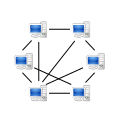 Image via Wikipedia
Image via WikipediaRetail forex trading is a small segment of the large foreign exchange market. In 2007 it had been speculated that volume from retail forex trading represents 5 percent of the whole forex market which amounts to $50-100 billion [1][2] in daily trading turnover. The retail forex market has been growing. In general retail customers are able to trade spot currencies. Due to the increasing tendency in the past years of the gradual shift from traditional intrabank 'paper' trading to the more advanced and accurate electronic trading, there has been spur in software development in this field. This change provided different types of trading platforms and tools intended for the use by banks, portfolio managers, retail brokers and retail traders.
One of the most important tools required to perform a forex transaction is the trading platform providing retail traders and brokers with accurate currency quotes.
Contents [hide]
1 History and new developments
2 Peer to Peer Trading Systems
3 Banks
4 References
[edit]History and new developments
Since 1996, when retail forex trading was first introduced, several brokers who lacked the sufficient tools developed their own trading platforms tailored specifically to their needs. The 1st retail FX brokers were MG Forex, The Matchbook FX ECN, GFT, CMC Markets, Saxo Bank (then known as Midas) and a handful of others. Most except CMC, Saxo & Matchbook FX were based on the ACT forex trading technology & GUI. These platforms were good enough at the time but required constant investments in R&D and this development cost too much. This was the first wave.[citation needed]
The second wave was in the early 2000s: several software companies entered the retail forex trading market by launching their own versions of trading platforms, like Apbg Group, Ctn Systems and MetaQuotes Software. Typically these versions were cumbersome for both front-end users (retail traders) and back-end users (retail brokers) due to the misunderstanding of the developers about the forex market and also because of the insufficient programming tools/languages at the time. Simultaneously most of the retail brokers kept using and developing their own systems as they waited for better platforms which were yet to be developed.
It is only in the last couple of years that the advanced trading platforms started to emerge. These platforms put much stronger emphasis on the user interface (GUI) making it more accessible to the retail traders while making trading on it very simple and intuitive. Moreover a very strong emphasis was put on the back-end which allowed the retail brokers better control over their operations, better reporting and accurate system and ways to manage marketing campaigns.[citation needed] Gradually this wave is replacing the previous second wave with a major shift now to the friendlier and more intuitive systems of the third wave which according to Aite Group are necessary in order to maintain growth [3].
[edit]Peer to Peer Trading Systems
In the South Pacific, "peer-to-peer" foreign exchange services, supported by local government agencies, are emerging in an attempt to reduce transaction costs to heavily remittance-dependent nations, such as Tonga and Samoa.[citation needed]
[edit]Banks
Nowadays, banks have also jumped on the retail forex trading platform bandwagon and have started offering those services to individual traders and money mangers, expanding the forex trading appeal. DBFX and CitiFX Pro are some of the banks that are currently offering this service.

No comments:
Post a Comment